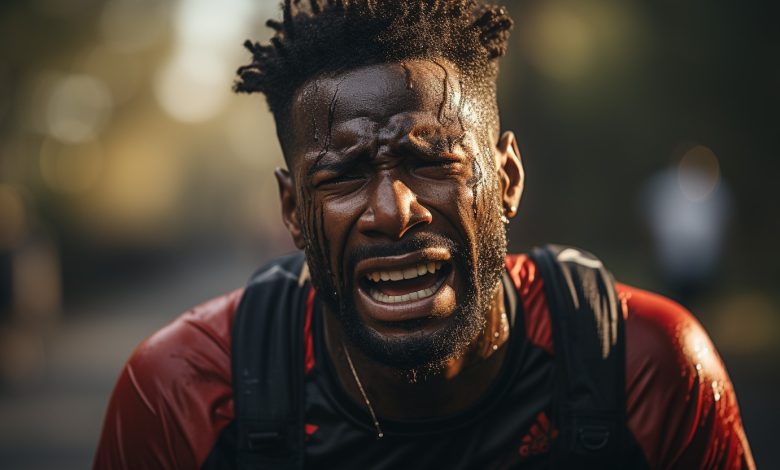Signs and Symptoms That Indicate a Serious Running Injury

Do you ever wonder if that pain you feel while running is just a minor ache or something more serious? Well, let me tell you, when it comes to running injuries, your body has a way of giving you signs and symptoms that can’t be ignored.
Pain that worsens with activity, swelling and inflammation in the affected area, difficulty bearing weight on the injured limb – these are all red flags indicating a potentially serious injury.
So pay attention and listen to what your body is trying to tell you.
Pain That Worsens With Activity

If you’re experiencing pain that gets worse when you’re active, it could be a sign of a serious running injury. Categorizing pain is crucial in determining the severity of an injury and guiding appropriate treatment. Pain that worsens with activity is often indicative of overuse injuries such as stress fractures, tendinitis, or muscle strains. These injuries occur due to repetitive motions and excessive strain on the muscles, bones, and joints involved in running.
When you notice pain that intensifies during physical activity, it’s essential to modify your activity levels to prevent further damage. Continuing to run through the pain can exacerbate the injury and prolong recovery time. Instead, consider reducing your mileage or taking a break from running altogether until the pain subsides.
Understanding how modifying activity levels can aid in healing is crucial for preventing long-term complications. By giving your body sufficient rest and allowing injured tissues to heal properly, you increase the likelihood of a faster recovery and reduce the risk of chronic conditions developing.
Transitioning into the subsequent section about swelling and inflammation in the affected area, it’s important to note that these symptoms often accompany persistent or severe pain. Swelling and inflammation are signs that your body is attempting to repair itself but may indicate more significant tissue damage requiring medical attention.
Swelling and Inflammation in the Affected Area

The affected area may become swollen and inflamed, causing discomfort. Swelling and inflammation are common signs of a serious running injury. When you experience these symptoms in the affected area, it can hinder your ability to perform basic activities such as walking or even standing for long periods of time. In some cases, there may also be visible bruising on the affected area.
To help you understand the seriousness of swelling and inflammation in a running injury, let’s take a look at this table:
| Symptoms | Emotion |
|---|---|
| Swelling | Frustration |
| Inflammation | Pain |
| Discomfort | Disappointment |
| Inability to perform basic activities | Helplessness |
| Visible bruising on the affected area | Alarm |
As you can see from the emotions associated with each symptom, swelling and inflammation can have a significant impact on your daily life. It is important to seek medical attention if you experience these symptoms after running or any physical activity. Taking proper care and allowing sufficient time for recovery is essential for healing and preventing further damage.
Difficulty Bearing Weight on the Injured Limb

When you have difficulty bearing weight on the injured limb, it can greatly impact your mobility and ability to perform daily activities. This is a significant sign that indicates a serious running injury. Here are three reasons why this symptom can evoke strong emotions in you:
1. Loss of independence: Difficulty walking or putting weight on the injured limb can make you feel dependent on others for help with even simple tasks like getting out of bed or going to the bathroom.
2. Frustration and limitations: Muscle weakness resulting from the injury may prevent you from participating in activities you enjoy, such as sports or hobbies, leading to feelings of frustration and a sense of loss.
3. Fear of long-term consequences: The inability to bear weight on the injured limb may raise concerns about long-term effects on your mobility and overall quality of life.
It is crucial to seek medical attention when experiencing difficulty walking or muscle weakness after sustaining an injury while running. Ignoring these symptoms could lead to further damage and delay recovery.
Transitioning into the subsequent section about ‘limited range of motion in the injured joint or muscle,’ understanding how these signs connect will provide a comprehensive understanding of potential serious running injuries.
Limited Range of Motion in the Injured Joint or Muscle

To improve your mobility and reduce discomfort, it’s important to address limited range of motion in the injured joint or muscle. Joint stiffness and muscle tightness can greatly impact your ability to move freely and perform daily activities. When you experience limited range of motion, it means that you are unable to fully extend or flex the affected joint or muscle.
Joint stiffness occurs when there is a decrease in the normal movement of the joint. This can be caused by inflammation, injury, or wear and tear on the joint. Muscle tightness, on the other hand, refers to a state where your muscles feel tense and contracted. This can result from overuse, improper training techniques, or muscular imbalances.
Addressing limited range of motion is crucial for both recovery and prevention of further injury. Stretching exercises specifically targeting the affected area can help increase flexibility and range of motion. Additionally, incorporating strength training exercises into your routine can improve stability around the joint or muscle.
It is important to consult with a healthcare professional such as a physical therapist who can provide you with specific exercises tailored to your condition. They will also be able to guide you through proper form and technique to ensure optimal results.
Persistent or Recurring Pain Even After Rest and Recovery Attempts

If rest and recovery attempts haven’t resolved your persistent or recurring pain, it’s important for you to seek further medical evaluation. While occasional aches and pains are common after intense physical activity like running, persistent or recurring pain can indicate a more serious underlying issue that requires attention. Ignoring this pain could lead to long term consequences and hinder your ability to enjoy an active lifestyle.
Here are three signs that indicate you should seek medical evaluation for your persistent or recurring pain:
1. Pain that worsens with activity: If your pain increases when you engage in physical activities such as running, it may be a sign of an injury that needs proper treatment. Continuing to push through the pain can aggravate the issue and potentially lead to long-term damage.
2. Pain accompanied by swelling or redness: Swelling and redness around the affected area can indicate inflammation or tissue damage. These symptoms should not be ignored, as they may require appropriate treatment options such as anti-inflammatory medication or physical therapy.
3. Pain that affects daily activities: If your persistent or recurring pain is interfering with your ability to perform everyday tasks, it’s crucial to seek medical evaluation. Your doctor can help identify the underlying cause of the pain and recommend appropriate treatments tailored to your specific needs.
Conclusion
So there you have it, my friend. Now that you’re armed with this wealth of knowledge, you can confidently identify the signs and symptoms of a serious running injury.
Remember, if your pain worsens with activity or if you experience swelling and inflammation in the affected area, it’s time to seek medical attention. Don’t ignore difficulty bearing weight on your injured limb or limited range of motion in the joint or muscle.
And if that persistent or recurring pain just won’t go away, even after rest and recovery attempts, don’t hesitate to get professional help.
Stay safe out there on those roads and trails!






